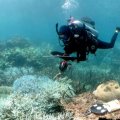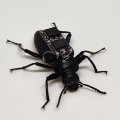The U.S. Air Force, the National Aeronautical Laboratory of Japan, and U.S. aerospace company GASL have joined a University of Queensland-led international space flight project to blast off this year.
Dr Allan Paull of UQ's Centre for Hypersonics said the Americans and Japanese would contribute $100,000 each to the Hyshot program which involves the world's first flight tests of a scramjet using supersonic combustion.
GASL will contribute in-kind support on heating analysis for the unique trajectory being undertaken by the HyShot program.
"GASL are well placed to undertake this analysis as they have provided major support of the Hyper-X program which is a NASA program to fly a hypersonic vehicle at approximately the same time as the HyShot flights," he said.
"The UQ connection with GASL goes back many years, with one of GASL's vice presidents obtaining his PhD at UQ's Centre for Hypersonics.
"They want to be involved in this unique project, which is being supported by groups from the U.S., Germany, Australia, Korea, and Britain.
"They are keen to access data from two test flight launches at Woomera in Australia on June 29 and July 5, 2001."
Cairns precision engineering firm NQEA has donated 400 hours of free machining of the high grade aluminium payload can, to be used in the project.
Scramjets are air-breathing supersonic combustion ramjet engines. They are set to revolutionise the launch of small space payloads, such as communications satellites, by substantially lowering costs.
Dr Paull said the project had passed its recent design review with flying colours, and reviewers were pleased with both the progress of the program and its complexity.
Two German students from Aachen Institute for Fluid Mechanics and an engineer from French firm Aerospatle are the latest international visitors to UQ to join scientists Dr Allan Paull, Dr Susan Anderson and engineer Dr Hans Alesi on the program.
The students will assist in manoeuvres to return the rockets to earth, a process which is being simulated on a gimbel test rig at UQ.
French engineer Nam-Bin Houng has assisted UQ's Emeritus Professor Ray Stalker and Dr David Mee in the rebuild of one of the University's major ground test facilities, the University's 40 metre long T4 shock tunnel.
The tunnel, which was designed by Professor Stalker and originally commissioned in 1987, simulates velocities for space craft to orbit the earth.
Professor Stalker designed the reconfiguration primarily to use higher pressures so that small scale models could be tested in the facility. The higher pressures are also needed to correlate the lower altitudes of the flight data from the HyShot Program.
Five tonnes of steel had to be shifted during the reconfiguration of the tunnel, which has witnessed 7000 test shots including simulation of flight for the European space vehicle Hermes, and models of the U.S. space shuttle.
The upgrade was carried out with Federal Government RIF and RIEFP grants totalling $300,000, and with the assistance of Brisbane engineering firm WBM.
Dr Paull said UQ scientists and their collaborators were working round the clock in the $1.25 million project.
"A lot of the elements are coming smoothly together to make the flight possible," he said. "We plan to launch two Terrier Orion rockets fitted with hypersonic air-breathing engine (scramjet) experiments at Woomera, 500km north of Adelaide."
Dr Paull said the HyShot Program would help underscore Australia's position at the forefront of hypersonic technological research. If successful, it would open the door to a new way of flight testing.
"The objectives of the HyShot program can be equated to breaking the sound barrier in flight, but for HyShot, it will be the combustion sound barrier that's broken," he said.
The program is supported by an international consortium including
- The University of Queensland,
- U.S. firms Astrotech Space Operations and GASL,
- DERA (The UK Defence Evaluation and Research Agency),
- NASA Langley Research Center,
- The DSTO (Defence Science and Technology Organisation, Australia),
- Seoul National University,
- the DLR (German Aerospace Center),
- NAL (National Aerospace lab. Japan),
- AFOSR (Air Force Office of Scientific Research, USA),
- and Australian Space Research Institute (ASRI).
Australian firms, Alesi Technologies, AECA, Luxfer Aust. and British Aerospace Australia will assist by providing operational and logistic support.
Funding has also been secured from:
- the Department of Industry, Science and Resources,
- the Australian Research Council and
- assistance and support from the Ministry of Defence.
Media: Dr Allan Paull, telephone 07 3365 3783, email: allan@mech.uq.edu.au Dr Susan Anderson, telephone 07 3365 3581, email: anderson@mech.uq.edu.au or Jan King, UQ Communications, telephone 07 3365 1120.
Additional contact details:
DSTO Mark Bateup phone 08 8259 7348 mark.bateup@dsto.defence.gov.au
Astrotech Morgan Windsor ph 301 982 7876 mwindsor@astrotechspace.com
DERA Dr Terry Cain ph 44 1252 395423, tcain@dera.gov.uk
NASA Dr Randy Voland r.t.voland@larc.nasa.gov
DLR Walter Beck ph 49-551-709 2470/2315 walter.beck@dlr.de
Photographs are available for downloading from the Hyshot folder on the ftp site: http://photos.cc.uq.edu.au/HYSHOT
A pic of Hyshot project team members: technician Rob Lowe, Dr Susan Anderson, engineer Dr Hans Alesi and Dr Allan Paull, with a scramjet to be used in the experiment is at: http://photos.cc.uq.edu.au/HYSHOT/index.htm
See also previous stories on Hyshot:
- October dates likely for UQ scramjet launches
- UQ to launch rockets to develop scramjet technology
.jpg)


